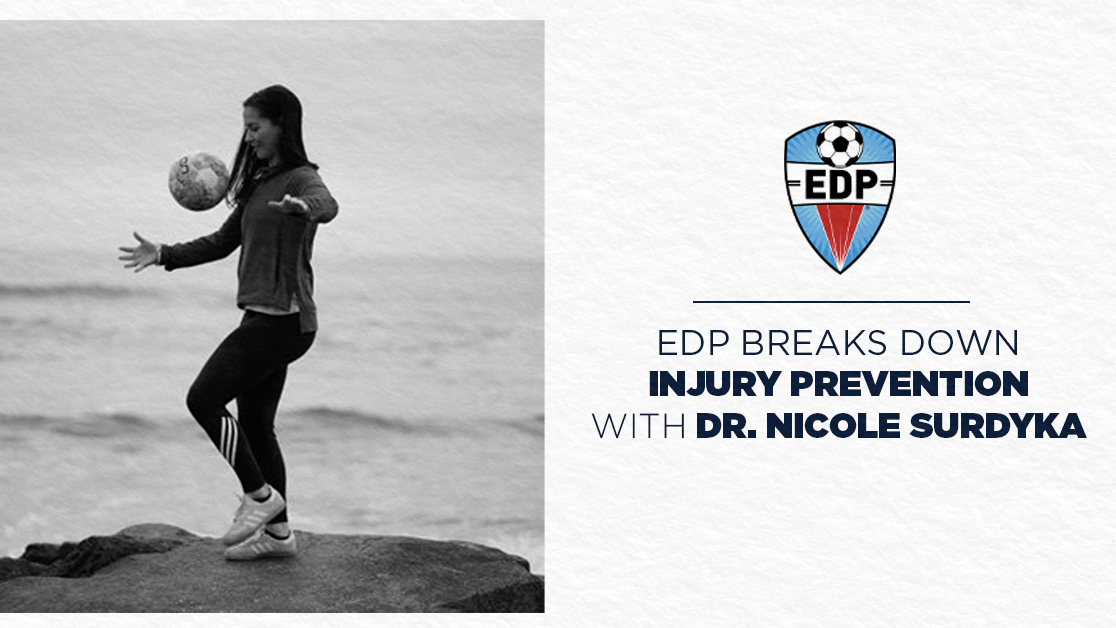EDP Soccer breaks down injury prevention with Dr. Nicole Surdyka

EDP Soccer spoke with Nicole Surdyka, Physical Therapist and former collegiate player at St. John’s and got her thoughts on Injury Prevention for when players return to the field.
See below what Dr. Surdyka had to say:
This is a very strange time. I wake up on Saturday mornings and there are no Arsenal games to watch (hey, they were beginning to hit their stride, ok?). I jog by the local parks and there are no youth soccer games going on. While the parents reading this may not necessarily miss driving all over the Northeast for games and tournaments, I’d venture a guess that we are all missing soccer in one form or another right about now.
In every challenging time, there is also opportunity. As a Physical Therapist and Performance Coach, I see this time away from organized soccer as an incredibly unique opportunity to help athletes get fitter and stronger, and implement strategies that will help reduce their risk of injury when they do go back to playing again. We should really be looking at this time as an extended pre-season. In fact, an increased number of pre-season training sessions is correlated with decreased injury rates during the competitive season.
If we’re going to try to reduce the risk of injuries incurred by soccer players, then it is important that we first know what types of injuries soccer players typically get. The Union of European Football Associations (UEFA) Champions League Study has been prospectively tracking top clubs from Europe every year since the 2001-02 season. Each year, they record time-lost injuries (injuries causing subsequent absence from training sessions and/or games) and individual player exposure times for all club and national team training sessions and games.They have found that the most common injury types in soccer players are strains and sprains, and the most commonly injured body areas are thigh > knee > hip/groin > ankle.
The UEFA Injury Study has given us some valuable information regarding the injury rates and patterns in male professional footballers. Within a team of 25 players, we can expect each player to sustain 2 injuries per season, with 8 injuries per team being severe (>28 days time loss). Reinjuries account for 12% of all injuries and cause longer absences from training and matches than the initial injuries do. The injury rate is significantly greater in matches than in training, and the injury incidence increases over the time course of a game in both the 1st and 2nd halves.
Strains and Sprains
Thigh strains make up 16% of all injuries, and 61% of all muscle strains are located in the thigh. Strains to the adductors (groin muscles) make up 21% of the muscle strains. The most common injury is a hamstring strain injury which accounts for 12% of all injuries. Over half of all sprains are to the ankle, and 39% are in the knee, of which 53% are to the medial collateral ligament (MCL). A third of all severe injuries occur in the knee. It’s important to note that some of these more severe injuries causing the greatest time loss from sport are not necessarily the most common injuries. For example, ACL injuries are not amongst the most common injuries seen, but they account for a significant amount of time loss from sport, so the burden of injury is quite high.
Injury Rates Affect Team Performance
Injuries have a negative impact on team performance. This might be due to increased injury rates leading to lower player availability which may not allow coaches to select the best players. On average, we can expect the player availability for training sessions to be 77% and 86% for matches. Injury rates’ negative impact on performance highlights the importance of investing in sports medicine and performance training programs for soccer players.
One of the greatest benefits of this epidemiological data is identifying the most common and the most significant injuries so that we can try to introduce some injury risk reduction interventions. The UEFA Champions League Study and all its sub-studies have shown us which injuries are most common at the professional level, and while there may actually be a ceiling effect for these risk reduction interventions in professional athletes, there is no such ceiling effect in youth athletes. It would behoove us, therefore, to begin injury risk reduction strategies for those injuries at the youth level to mitigate their risk as they progress through age brackets and competition level.
So what can you be doing at home, right now, to help reduce the risk of injury once soccer begins again?
A good injury risk reduction program serves not only to reduce the risk of injuries, but also helps to improve athletic performance. The components of effective injury risk reduction programs are that they are implemented at the youth level, begin in the pre-season and continue through the regular season, are performed multiple times per week for an overall time of at least 30 minutes per week, are multifaceted and include a combination of strength and plyometric exercises, and they must have a high level of compliance. Even the best program in the world won’t work if it doesn’t get done.
There are a number of free programs available online that you can be doing at home with no equipment whatsoever! The FIFA 11+ is a dynamic warm-up that has been proven to reduce the risk of injury in soccer players. It is incredibly easy to do, takes 15-20 minutes, and does not require equipment. Another similar program is called the Prevent injury and Enhance Performance (PEP) Program.
Following a program like the ones mentioned above is an incredibly convenient and effective way to reduce your risk of injury while playing soccer. Now is the perfect time to begin implementing these programs. Don’t let this time go to waste – get to work instead!
If you have any specific questions about injury risk reduction strategies, feel free to reach out to me at [email protected]
References:
1. Ekstrand J, Spreco A, Windt J, Khan KM. Are Elite Soccer Teams’ Preseason Training Sessions Associated With Fewer In-Season Injuries? A 15-Year Analysis From the Union of European Football Associations (UEFA) Elite Club Injury Study. The American Journal of Sports Medicine. 2020;48(3):723-729. doi:10.1177/0363546519899359
2. Walden M. UEFA Champions League study: a prospective study of injuries in professional football during the 2001-2002 season. British Journal of Sports Medicine. 2005;39(8):542-546. doi:10.1136/bjsm.2004.014571
3. Ekstrand J, Hagglund M, Walden M. Injury incidence and injury patterns in professional football: the UEFA injury study. British Journal of Sports Medicine. 2011;45(7):553-558. doi:10.1136/bjsm.2009.060582
5. Arundale A, Bizzini M, Giordano A, et al. EXERCISE-BASED KNEE INJURY PREVENTION CLINICAL PRACTICE GUIDELINES. British Journal of Sports Medicine. 2017;51(4):288.3-289. doi:10.1136/bjsports-2016-097372.13
SOCCERWIRE MARKETPLACE
- Adidas National Cup 2026
- Adidas Showcase 2025
- Adidas Preseason Clash 2025
- Capital Fall Classic 2025 - Register by October 1st
- Applications are Now Open for the 2026 Jefferson Cup
- Start the Season Strong at Loudoun Premier Cup!
- 50th Annual Rael Vodicka Memorial Tournament
- Soccer Marketing Internships at The St. James FC
- Job Opening: The St. James FC Goalkeeper Academy Coach
- Full-Time Director of Goalkeeping for The St. James FC














